SHNXGB3023 Report: Effective Caring, Quality of Life, and HSC
VerifiedAdded on 2023/06/04
|13
|3759
|236
Report
AI Summary
This report delves into the multifaceted concept of effective caring within the Health and Social Care (HSC) sector. It begins by defining effective caring as a process tailored to individual needs, emphasizing the importance of quality of life, which is influenced by physical, emotional, social, and intellectual factors. The report then outlines key caring techniques, drawing upon the CARE model, including encouraging, social perception, safe working practices, observation, and showing approval. Furthermore, the report addresses constraints to positive caring, such as financial difficulties, communication challenges, changing government policies, and a lack of awareness. The analysis underscores how these factors collectively impact the delivery of quality patient care within HSC settings, providing insights into the complexities of creating a supportive and effective care environment.

SHNXGB3023 Report
Paraphrase This Document
Need a fresh take? Get an instant paraphrase of this document with our AI Paraphraser
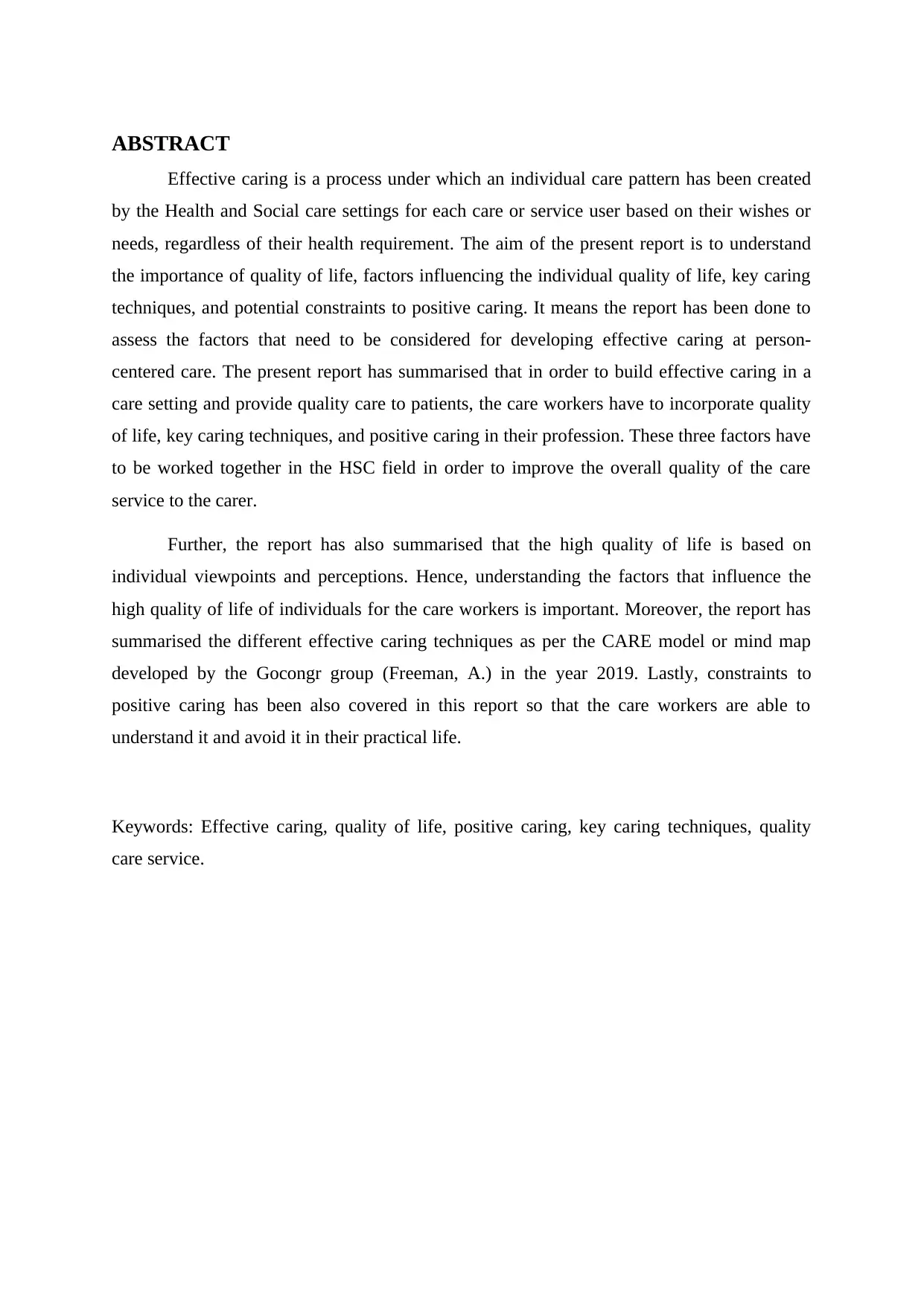
ABSTRACT
Effective caring is a process under which an individual care pattern has been created
by the Health and Social care settings for each care or service user based on their wishes or
needs, regardless of their health requirement. The aim of the present report is to understand
the importance of quality of life, factors influencing the individual quality of life, key caring
techniques, and potential constraints to positive caring. It means the report has been done to
assess the factors that need to be considered for developing effective caring at person-
centered care. The present report has summarised that in order to build effective caring in a
care setting and provide quality care to patients, the care workers have to incorporate quality
of life, key caring techniques, and positive caring in their profession. These three factors have
to be worked together in the HSC field in order to improve the overall quality of the care
service to the carer.
Further, the report has also summarised that the high quality of life is based on
individual viewpoints and perceptions. Hence, understanding the factors that influence the
high quality of life of individuals for the care workers is important. Moreover, the report has
summarised the different effective caring techniques as per the CARE model or mind map
developed by the Gocongr group (Freeman, A.) in the year 2019. Lastly, constraints to
positive caring has been also covered in this report so that the care workers are able to
understand it and avoid it in their practical life.
Keywords: Effective caring, quality of life, positive caring, key caring techniques, quality
care service.
Effective caring is a process under which an individual care pattern has been created
by the Health and Social care settings for each care or service user based on their wishes or
needs, regardless of their health requirement. The aim of the present report is to understand
the importance of quality of life, factors influencing the individual quality of life, key caring
techniques, and potential constraints to positive caring. It means the report has been done to
assess the factors that need to be considered for developing effective caring at person-
centered care. The present report has summarised that in order to build effective caring in a
care setting and provide quality care to patients, the care workers have to incorporate quality
of life, key caring techniques, and positive caring in their profession. These three factors have
to be worked together in the HSC field in order to improve the overall quality of the care
service to the carer.
Further, the report has also summarised that the high quality of life is based on
individual viewpoints and perceptions. Hence, understanding the factors that influence the
high quality of life of individuals for the care workers is important. Moreover, the report has
summarised the different effective caring techniques as per the CARE model or mind map
developed by the Gocongr group (Freeman, A.) in the year 2019. Lastly, constraints to
positive caring has been also covered in this report so that the care workers are able to
understand it and avoid it in their practical life.
Keywords: Effective caring, quality of life, positive caring, key caring techniques, quality
care service.
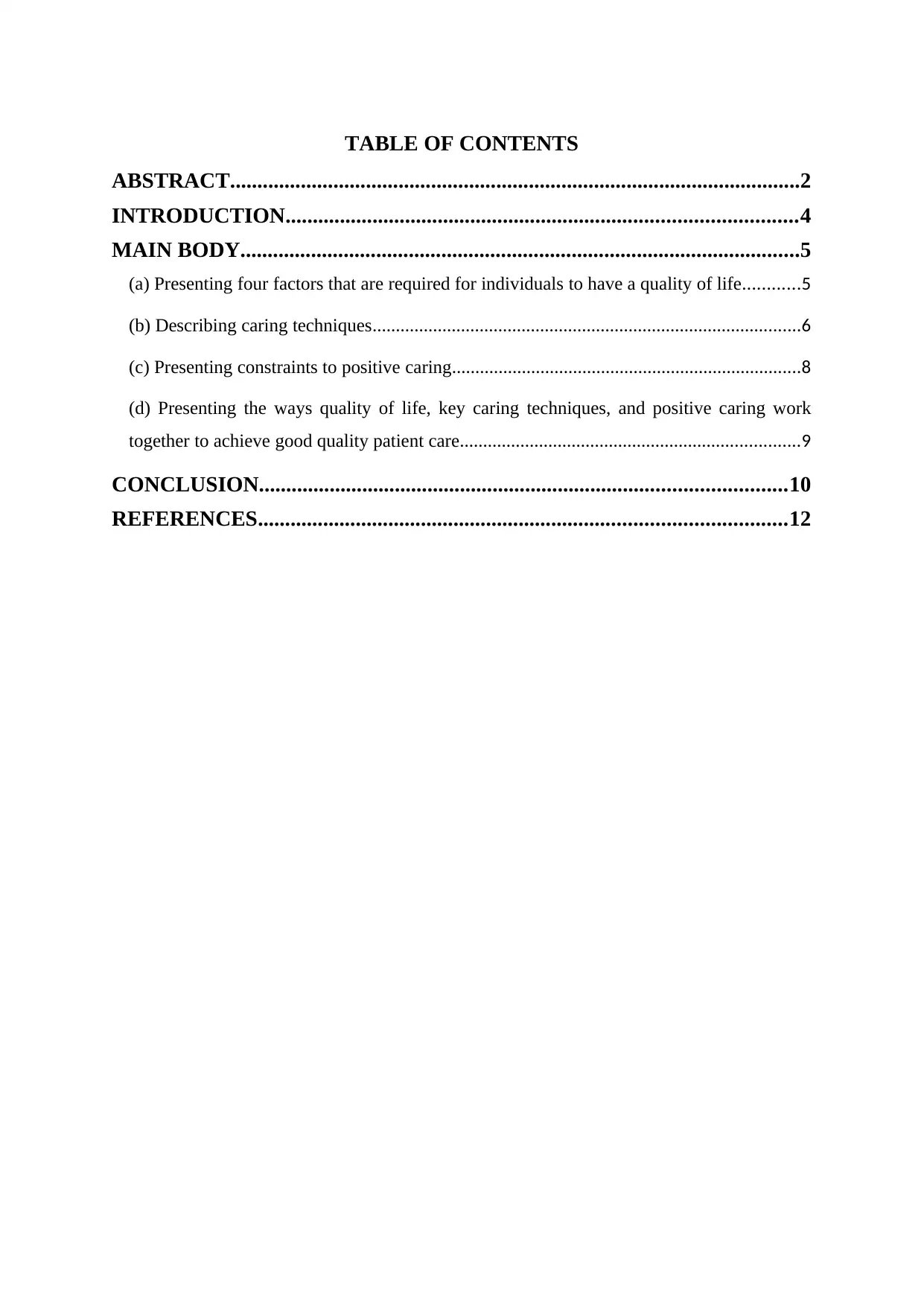
TABLE OF CONTENTS
ABSTRACT.........................................................................................................2
INTRODUCTION..............................................................................................4
MAIN BODY.......................................................................................................5
(a) Presenting four factors that are required for individuals to have a quality of life............5
(b) Describing caring techniques............................................................................................6
(c) Presenting constraints to positive caring...........................................................................8
(d) Presenting the ways quality of life, key caring techniques, and positive caring work
together to achieve good quality patient care.........................................................................9
CONCLUSION.................................................................................................10
REFERENCES.................................................................................................12
ABSTRACT.........................................................................................................2
INTRODUCTION..............................................................................................4
MAIN BODY.......................................................................................................5
(a) Presenting four factors that are required for individuals to have a quality of life............5
(b) Describing caring techniques............................................................................................6
(c) Presenting constraints to positive caring...........................................................................8
(d) Presenting the ways quality of life, key caring techniques, and positive caring work
together to achieve good quality patient care.........................................................................9
CONCLUSION.................................................................................................10
REFERENCES.................................................................................................12
⊘ This is a preview!⊘
Do you want full access?
Subscribe today to unlock all pages.

Trusted by 1+ million students worldwide
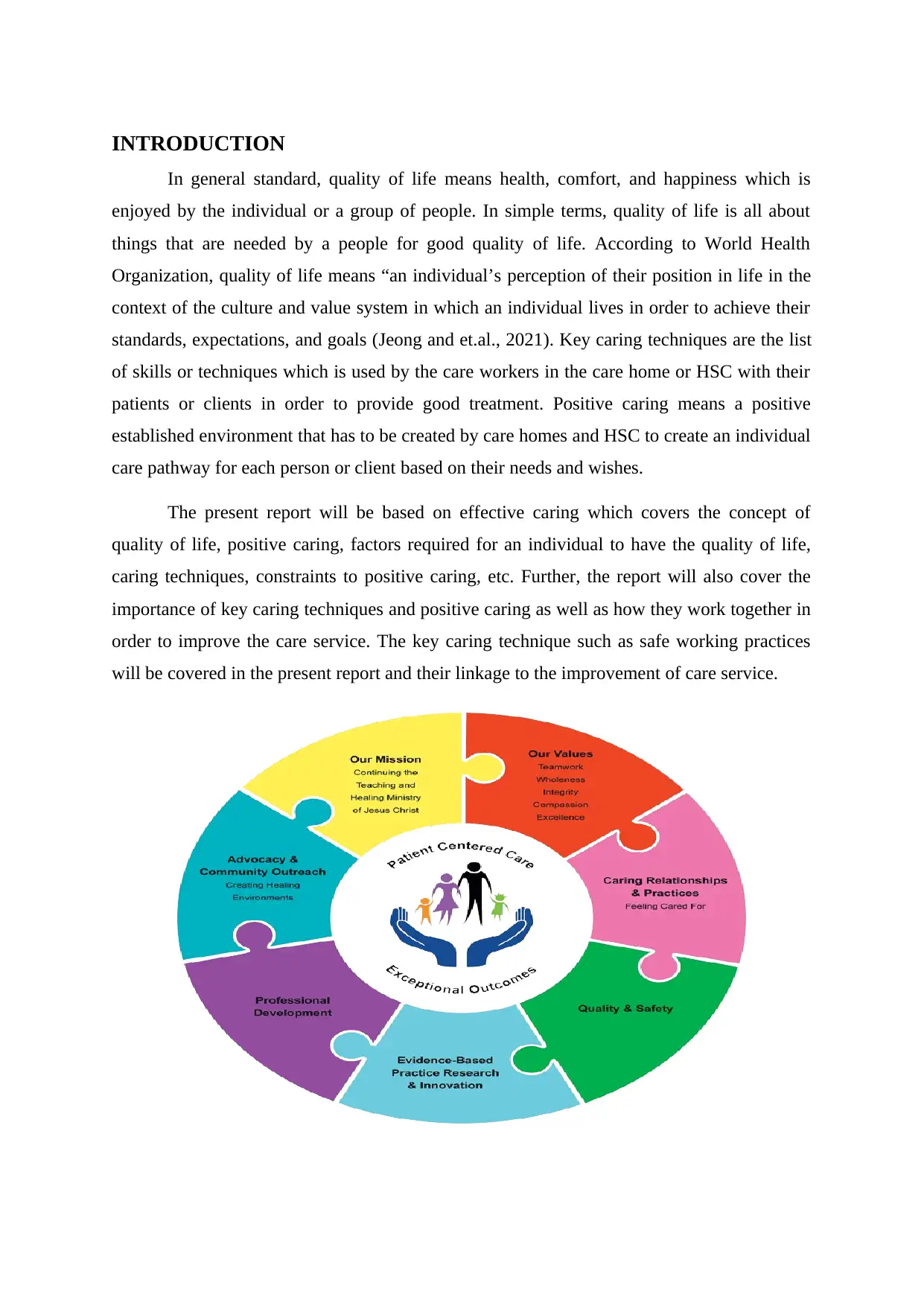
INTRODUCTION
In general standard, quality of life means health, comfort, and happiness which is
enjoyed by the individual or a group of people. In simple terms, quality of life is all about
things that are needed by a people for good quality of life. According to World Health
Organization, quality of life means “an individual’s perception of their position in life in the
context of the culture and value system in which an individual lives in order to achieve their
standards, expectations, and goals (Jeong and et.al., 2021). Key caring techniques are the list
of skills or techniques which is used by the care workers in the care home or HSC with their
patients or clients in order to provide good treatment. Positive caring means a positive
established environment that has to be created by care homes and HSC to create an individual
care pathway for each person or client based on their needs and wishes.
The present report will be based on effective caring which covers the concept of
quality of life, positive caring, factors required for an individual to have the quality of life,
caring techniques, constraints to positive caring, etc. Further, the report will also cover the
importance of key caring techniques and positive caring as well as how they work together in
order to improve the care service. The key caring technique such as safe working practices
will be covered in the present report and their linkage to the improvement of care service.
In general standard, quality of life means health, comfort, and happiness which is
enjoyed by the individual or a group of people. In simple terms, quality of life is all about
things that are needed by a people for good quality of life. According to World Health
Organization, quality of life means “an individual’s perception of their position in life in the
context of the culture and value system in which an individual lives in order to achieve their
standards, expectations, and goals (Jeong and et.al., 2021). Key caring techniques are the list
of skills or techniques which is used by the care workers in the care home or HSC with their
patients or clients in order to provide good treatment. Positive caring means a positive
established environment that has to be created by care homes and HSC to create an individual
care pathway for each person or client based on their needs and wishes.
The present report will be based on effective caring which covers the concept of
quality of life, positive caring, factors required for an individual to have the quality of life,
caring techniques, constraints to positive caring, etc. Further, the report will also cover the
importance of key caring techniques and positive caring as well as how they work together in
order to improve the care service. The key caring technique such as safe working practices
will be covered in the present report and their linkage to the improvement of care service.
Paraphrase This Document
Need a fresh take? Get an instant paraphrase of this document with our AI Paraphraser
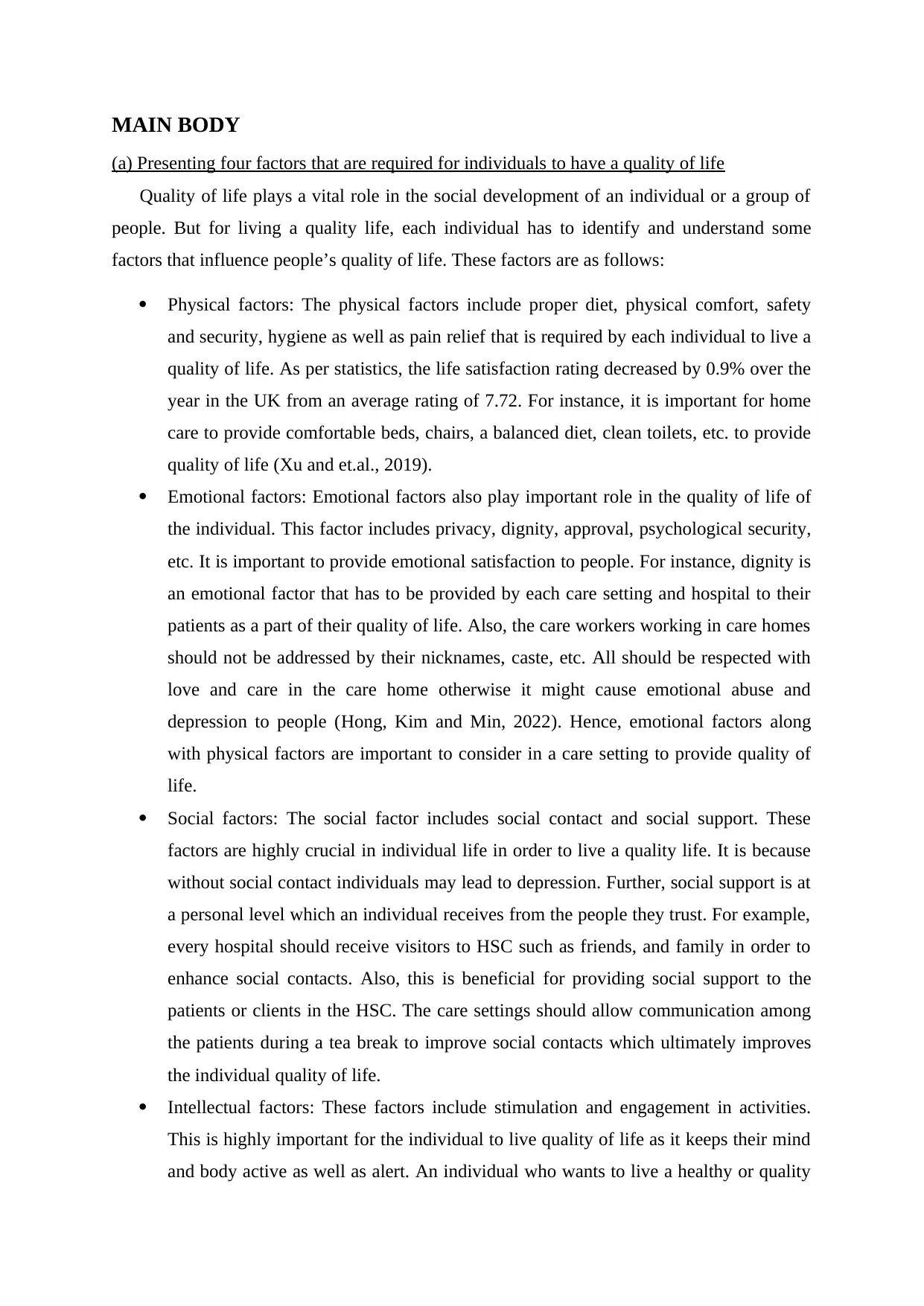
MAIN BODY
(a) Presenting four factors that are required for individuals to have a quality of life
Quality of life plays a vital role in the social development of an individual or a group of
people. But for living a quality life, each individual has to identify and understand some
factors that influence people’s quality of life. These factors are as follows:
Physical factors: The physical factors include proper diet, physical comfort, safety
and security, hygiene as well as pain relief that is required by each individual to live a
quality of life. As per statistics, the life satisfaction rating decreased by 0.9% over the
year in the UK from an average rating of 7.72. For instance, it is important for home
care to provide comfortable beds, chairs, a balanced diet, clean toilets, etc. to provide
quality of life (Xu and et.al., 2019).
Emotional factors: Emotional factors also play important role in the quality of life of
the individual. This factor includes privacy, dignity, approval, psychological security,
etc. It is important to provide emotional satisfaction to people. For instance, dignity is
an emotional factor that has to be provided by each care setting and hospital to their
patients as a part of their quality of life. Also, the care workers working in care homes
should not be addressed by their nicknames, caste, etc. All should be respected with
love and care in the care home otherwise it might cause emotional abuse and
depression to people (Hong, Kim and Min, 2022). Hence, emotional factors along
with physical factors are important to consider in a care setting to provide quality of
life.
Social factors: The social factor includes social contact and social support. These
factors are highly crucial in individual life in order to live a quality life. It is because
without social contact individuals may lead to depression. Further, social support is at
a personal level which an individual receives from the people they trust. For example,
every hospital should receive visitors to HSC such as friends, and family in order to
enhance social contacts. Also, this is beneficial for providing social support to the
patients or clients in the HSC. The care settings should allow communication among
the patients during a tea break to improve social contacts which ultimately improves
the individual quality of life.
Intellectual factors: These factors include stimulation and engagement in activities.
This is highly important for the individual to live quality of life as it keeps their mind
and body active as well as alert. An individual who wants to live a healthy or quality
(a) Presenting four factors that are required for individuals to have a quality of life
Quality of life plays a vital role in the social development of an individual or a group of
people. But for living a quality life, each individual has to identify and understand some
factors that influence people’s quality of life. These factors are as follows:
Physical factors: The physical factors include proper diet, physical comfort, safety
and security, hygiene as well as pain relief that is required by each individual to live a
quality of life. As per statistics, the life satisfaction rating decreased by 0.9% over the
year in the UK from an average rating of 7.72. For instance, it is important for home
care to provide comfortable beds, chairs, a balanced diet, clean toilets, etc. to provide
quality of life (Xu and et.al., 2019).
Emotional factors: Emotional factors also play important role in the quality of life of
the individual. This factor includes privacy, dignity, approval, psychological security,
etc. It is important to provide emotional satisfaction to people. For instance, dignity is
an emotional factor that has to be provided by each care setting and hospital to their
patients as a part of their quality of life. Also, the care workers working in care homes
should not be addressed by their nicknames, caste, etc. All should be respected with
love and care in the care home otherwise it might cause emotional abuse and
depression to people (Hong, Kim and Min, 2022). Hence, emotional factors along
with physical factors are important to consider in a care setting to provide quality of
life.
Social factors: The social factor includes social contact and social support. These
factors are highly crucial in individual life in order to live a quality life. It is because
without social contact individuals may lead to depression. Further, social support is at
a personal level which an individual receives from the people they trust. For example,
every hospital should receive visitors to HSC such as friends, and family in order to
enhance social contacts. Also, this is beneficial for providing social support to the
patients or clients in the HSC. The care settings should allow communication among
the patients during a tea break to improve social contacts which ultimately improves
the individual quality of life.
Intellectual factors: These factors include stimulation and engagement in activities.
This is highly important for the individual to live quality of life as it keeps their mind
and body active as well as alert. An individual who wants to live a healthy or quality
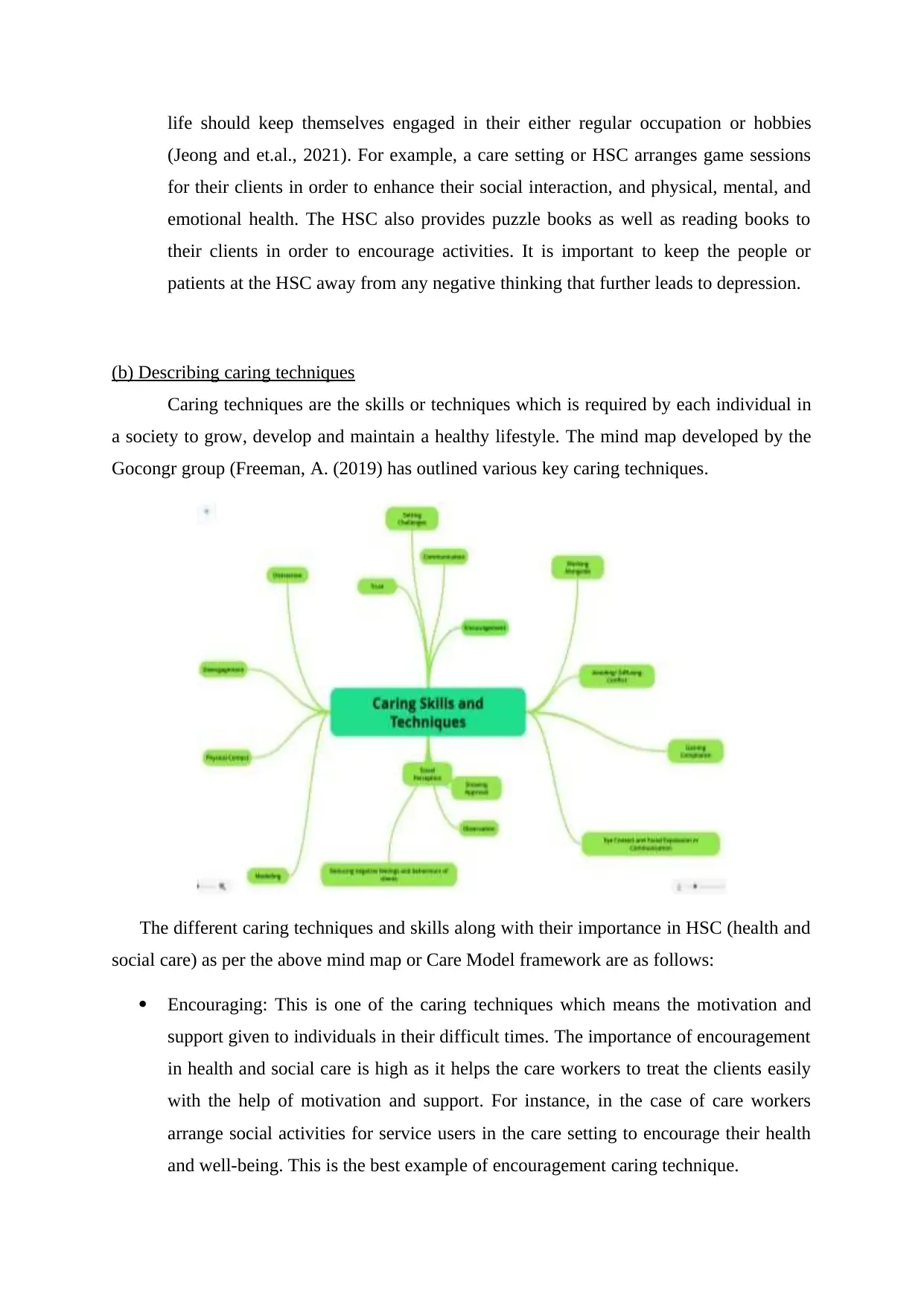
life should keep themselves engaged in their either regular occupation or hobbies
(Jeong and et.al., 2021). For example, a care setting or HSC arranges game sessions
for their clients in order to enhance their social interaction, and physical, mental, and
emotional health. The HSC also provides puzzle books as well as reading books to
their clients in order to encourage activities. It is important to keep the people or
patients at the HSC away from any negative thinking that further leads to depression.
(b) Describing caring techniques
Caring techniques are the skills or techniques which is required by each individual in
a society to grow, develop and maintain a healthy lifestyle. The mind map developed by the
Gocongr group (Freeman, A. (2019) has outlined various key caring techniques.
The different caring techniques and skills along with their importance in HSC (health and
social care) as per the above mind map or Care Model framework are as follows:
Encouraging: This is one of the caring techniques which means the motivation and
support given to individuals in their difficult times. The importance of encouragement
in health and social care is high as it helps the care workers to treat the clients easily
with the help of motivation and support. For instance, in the case of care workers
arrange social activities for service users in the care setting to encourage their health
and well-being. This is the best example of encouragement caring technique.
(Jeong and et.al., 2021). For example, a care setting or HSC arranges game sessions
for their clients in order to enhance their social interaction, and physical, mental, and
emotional health. The HSC also provides puzzle books as well as reading books to
their clients in order to encourage activities. It is important to keep the people or
patients at the HSC away from any negative thinking that further leads to depression.
(b) Describing caring techniques
Caring techniques are the skills or techniques which is required by each individual in
a society to grow, develop and maintain a healthy lifestyle. The mind map developed by the
Gocongr group (Freeman, A. (2019) has outlined various key caring techniques.
The different caring techniques and skills along with their importance in HSC (health and
social care) as per the above mind map or Care Model framework are as follows:
Encouraging: This is one of the caring techniques which means the motivation and
support given to individuals in their difficult times. The importance of encouragement
in health and social care is high as it helps the care workers to treat the clients easily
with the help of motivation and support. For instance, in the case of care workers
arrange social activities for service users in the care setting to encourage their health
and well-being. This is the best example of encouragement caring technique.
⊘ This is a preview!⊘
Do you want full access?
Subscribe today to unlock all pages.

Trusted by 1+ million students worldwide
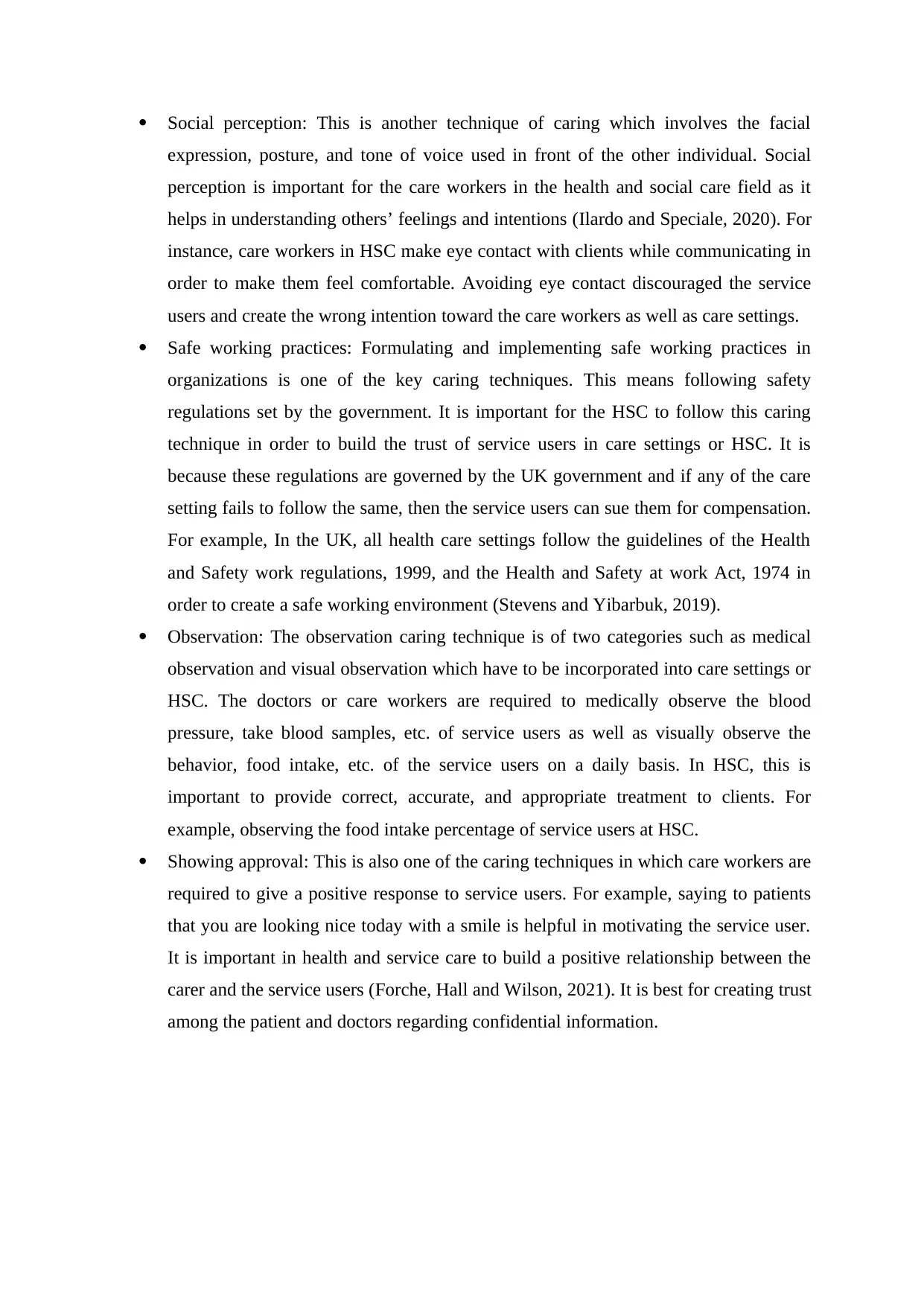
Social perception: This is another technique of caring which involves the facial
expression, posture, and tone of voice used in front of the other individual. Social
perception is important for the care workers in the health and social care field as it
helps in understanding others’ feelings and intentions (Ilardo and Speciale, 2020). For
instance, care workers in HSC make eye contact with clients while communicating in
order to make them feel comfortable. Avoiding eye contact discouraged the service
users and create the wrong intention toward the care workers as well as care settings.
Safe working practices: Formulating and implementing safe working practices in
organizations is one of the key caring techniques. This means following safety
regulations set by the government. It is important for the HSC to follow this caring
technique in order to build the trust of service users in care settings or HSC. It is
because these regulations are governed by the UK government and if any of the care
setting fails to follow the same, then the service users can sue them for compensation.
For example, In the UK, all health care settings follow the guidelines of the Health
and Safety work regulations, 1999, and the Health and Safety at work Act, 1974 in
order to create a safe working environment (Stevens and Yibarbuk, 2019).
Observation: The observation caring technique is of two categories such as medical
observation and visual observation which have to be incorporated into care settings or
HSC. The doctors or care workers are required to medically observe the blood
pressure, take blood samples, etc. of service users as well as visually observe the
behavior, food intake, etc. of the service users on a daily basis. In HSC, this is
important to provide correct, accurate, and appropriate treatment to clients. For
example, observing the food intake percentage of service users at HSC.
Showing approval: This is also one of the caring techniques in which care workers are
required to give a positive response to service users. For example, saying to patients
that you are looking nice today with a smile is helpful in motivating the service user.
It is important in health and service care to build a positive relationship between the
carer and the service users (Forche, Hall and Wilson, 2021). It is best for creating trust
among the patient and doctors regarding confidential information.
expression, posture, and tone of voice used in front of the other individual. Social
perception is important for the care workers in the health and social care field as it
helps in understanding others’ feelings and intentions (Ilardo and Speciale, 2020). For
instance, care workers in HSC make eye contact with clients while communicating in
order to make them feel comfortable. Avoiding eye contact discouraged the service
users and create the wrong intention toward the care workers as well as care settings.
Safe working practices: Formulating and implementing safe working practices in
organizations is one of the key caring techniques. This means following safety
regulations set by the government. It is important for the HSC to follow this caring
technique in order to build the trust of service users in care settings or HSC. It is
because these regulations are governed by the UK government and if any of the care
setting fails to follow the same, then the service users can sue them for compensation.
For example, In the UK, all health care settings follow the guidelines of the Health
and Safety work regulations, 1999, and the Health and Safety at work Act, 1974 in
order to create a safe working environment (Stevens and Yibarbuk, 2019).
Observation: The observation caring technique is of two categories such as medical
observation and visual observation which have to be incorporated into care settings or
HSC. The doctors or care workers are required to medically observe the blood
pressure, take blood samples, etc. of service users as well as visually observe the
behavior, food intake, etc. of the service users on a daily basis. In HSC, this is
important to provide correct, accurate, and appropriate treatment to clients. For
example, observing the food intake percentage of service users at HSC.
Showing approval: This is also one of the caring techniques in which care workers are
required to give a positive response to service users. For example, saying to patients
that you are looking nice today with a smile is helpful in motivating the service user.
It is important in health and service care to build a positive relationship between the
carer and the service users (Forche, Hall and Wilson, 2021). It is best for creating trust
among the patient and doctors regarding confidential information.
Paraphrase This Document
Need a fresh take? Get an instant paraphrase of this document with our AI Paraphraser
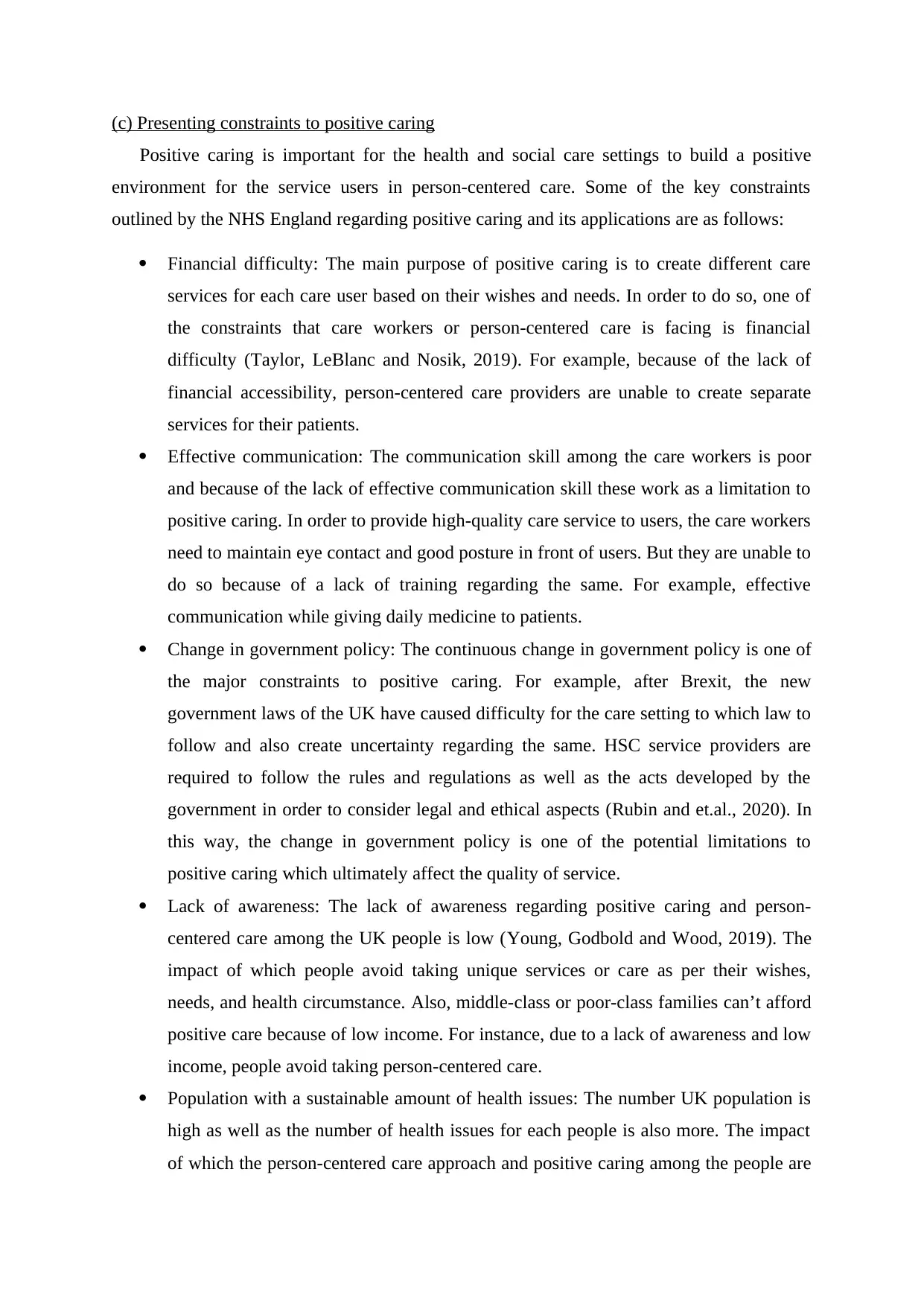
(c) Presenting constraints to positive caring
Positive caring is important for the health and social care settings to build a positive
environment for the service users in person-centered care. Some of the key constraints
outlined by the NHS England regarding positive caring and its applications are as follows:
Financial difficulty: The main purpose of positive caring is to create different care
services for each care user based on their wishes and needs. In order to do so, one of
the constraints that care workers or person-centered care is facing is financial
difficulty (Taylor, LeBlanc and Nosik, 2019). For example, because of the lack of
financial accessibility, person-centered care providers are unable to create separate
services for their patients.
Effective communication: The communication skill among the care workers is poor
and because of the lack of effective communication skill these work as a limitation to
positive caring. In order to provide high-quality care service to users, the care workers
need to maintain eye contact and good posture in front of users. But they are unable to
do so because of a lack of training regarding the same. For example, effective
communication while giving daily medicine to patients.
Change in government policy: The continuous change in government policy is one of
the major constraints to positive caring. For example, after Brexit, the new
government laws of the UK have caused difficulty for the care setting to which law to
follow and also create uncertainty regarding the same. HSC service providers are
required to follow the rules and regulations as well as the acts developed by the
government in order to consider legal and ethical aspects (Rubin and et.al., 2020). In
this way, the change in government policy is one of the potential limitations to
positive caring which ultimately affect the quality of service.
Lack of awareness: The lack of awareness regarding positive caring and person-
centered care among the UK people is low (Young, Godbold and Wood, 2019). The
impact of which people avoid taking unique services or care as per their wishes,
needs, and health circumstance. Also, middle-class or poor-class families can’t afford
positive care because of low income. For instance, due to a lack of awareness and low
income, people avoid taking person-centered care.
Population with a sustainable amount of health issues: The number UK population is
high as well as the number of health issues for each people is also more. The impact
of which the person-centered care approach and positive caring among the people are
Positive caring is important for the health and social care settings to build a positive
environment for the service users in person-centered care. Some of the key constraints
outlined by the NHS England regarding positive caring and its applications are as follows:
Financial difficulty: The main purpose of positive caring is to create different care
services for each care user based on their wishes and needs. In order to do so, one of
the constraints that care workers or person-centered care is facing is financial
difficulty (Taylor, LeBlanc and Nosik, 2019). For example, because of the lack of
financial accessibility, person-centered care providers are unable to create separate
services for their patients.
Effective communication: The communication skill among the care workers is poor
and because of the lack of effective communication skill these work as a limitation to
positive caring. In order to provide high-quality care service to users, the care workers
need to maintain eye contact and good posture in front of users. But they are unable to
do so because of a lack of training regarding the same. For example, effective
communication while giving daily medicine to patients.
Change in government policy: The continuous change in government policy is one of
the major constraints to positive caring. For example, after Brexit, the new
government laws of the UK have caused difficulty for the care setting to which law to
follow and also create uncertainty regarding the same. HSC service providers are
required to follow the rules and regulations as well as the acts developed by the
government in order to consider legal and ethical aspects (Rubin and et.al., 2020). In
this way, the change in government policy is one of the potential limitations to
positive caring which ultimately affect the quality of service.
Lack of awareness: The lack of awareness regarding positive caring and person-
centered care among the UK people is low (Young, Godbold and Wood, 2019). The
impact of which people avoid taking unique services or care as per their wishes,
needs, and health circumstance. Also, middle-class or poor-class families can’t afford
positive care because of low income. For instance, due to a lack of awareness and low
income, people avoid taking person-centered care.
Population with a sustainable amount of health issues: The number UK population is
high as well as the number of health issues for each people is also more. The impact
of which the person-centered care approach and positive caring among the people are
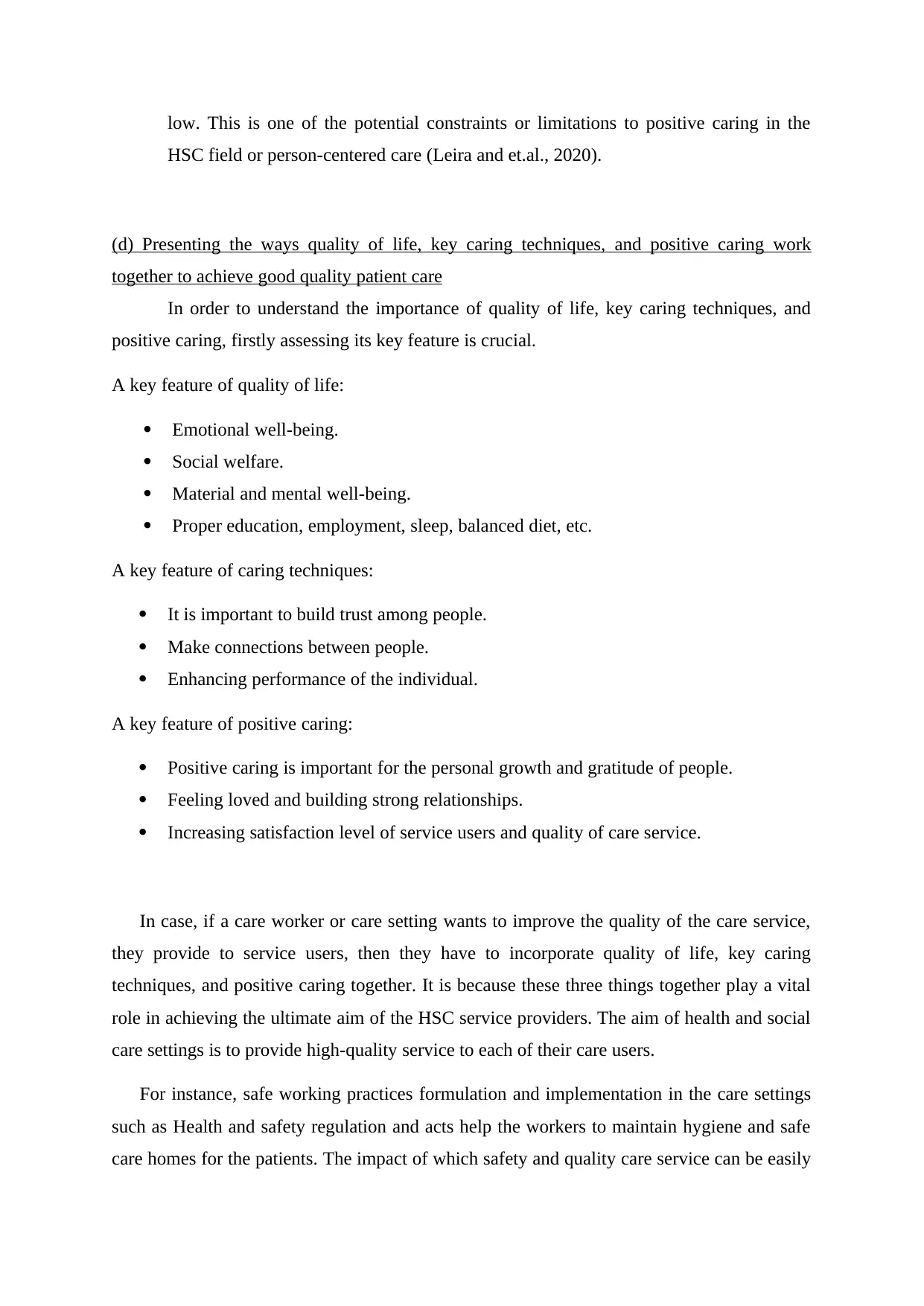
low. This is one of the potential constraints or limitations to positive caring in the
HSC field or person-centered care (Leira and et.al., 2020).
(d) Presenting the ways quality of life, key caring techniques, and positive caring work
together to achieve good quality patient care
In order to understand the importance of quality of life, key caring techniques, and
positive caring, firstly assessing its key feature is crucial.
A key feature of quality of life:
Emotional well-being.
Social welfare.
Material and mental well-being.
Proper education, employment, sleep, balanced diet, etc.
A key feature of caring techniques:
It is important to build trust among people.
Make connections between people.
Enhancing performance of the individual.
A key feature of positive caring:
Positive caring is important for the personal growth and gratitude of people.
Feeling loved and building strong relationships.
Increasing satisfaction level of service users and quality of care service.
In case, if a care worker or care setting wants to improve the quality of the care service,
they provide to service users, then they have to incorporate quality of life, key caring
techniques, and positive caring together. It is because these three things together play a vital
role in achieving the ultimate aim of the HSC service providers. The aim of health and social
care settings is to provide high-quality service to each of their care users.
For instance, safe working practices formulation and implementation in the care settings
such as Health and safety regulation and acts help the workers to maintain hygiene and safe
care homes for the patients. The impact of which safety and quality care service can be easily
HSC field or person-centered care (Leira and et.al., 2020).
(d) Presenting the ways quality of life, key caring techniques, and positive caring work
together to achieve good quality patient care
In order to understand the importance of quality of life, key caring techniques, and
positive caring, firstly assessing its key feature is crucial.
A key feature of quality of life:
Emotional well-being.
Social welfare.
Material and mental well-being.
Proper education, employment, sleep, balanced diet, etc.
A key feature of caring techniques:
It is important to build trust among people.
Make connections between people.
Enhancing performance of the individual.
A key feature of positive caring:
Positive caring is important for the personal growth and gratitude of people.
Feeling loved and building strong relationships.
Increasing satisfaction level of service users and quality of care service.
In case, if a care worker or care setting wants to improve the quality of the care service,
they provide to service users, then they have to incorporate quality of life, key caring
techniques, and positive caring together. It is because these three things together play a vital
role in achieving the ultimate aim of the HSC service providers. The aim of health and social
care settings is to provide high-quality service to each of their care users.
For instance, safe working practices formulation and implementation in the care settings
such as Health and safety regulation and acts help the workers to maintain hygiene and safe
care homes for the patients. The impact of which safety and quality care service can be easily
⊘ This is a preview!⊘
Do you want full access?
Subscribe today to unlock all pages.

Trusted by 1+ million students worldwide
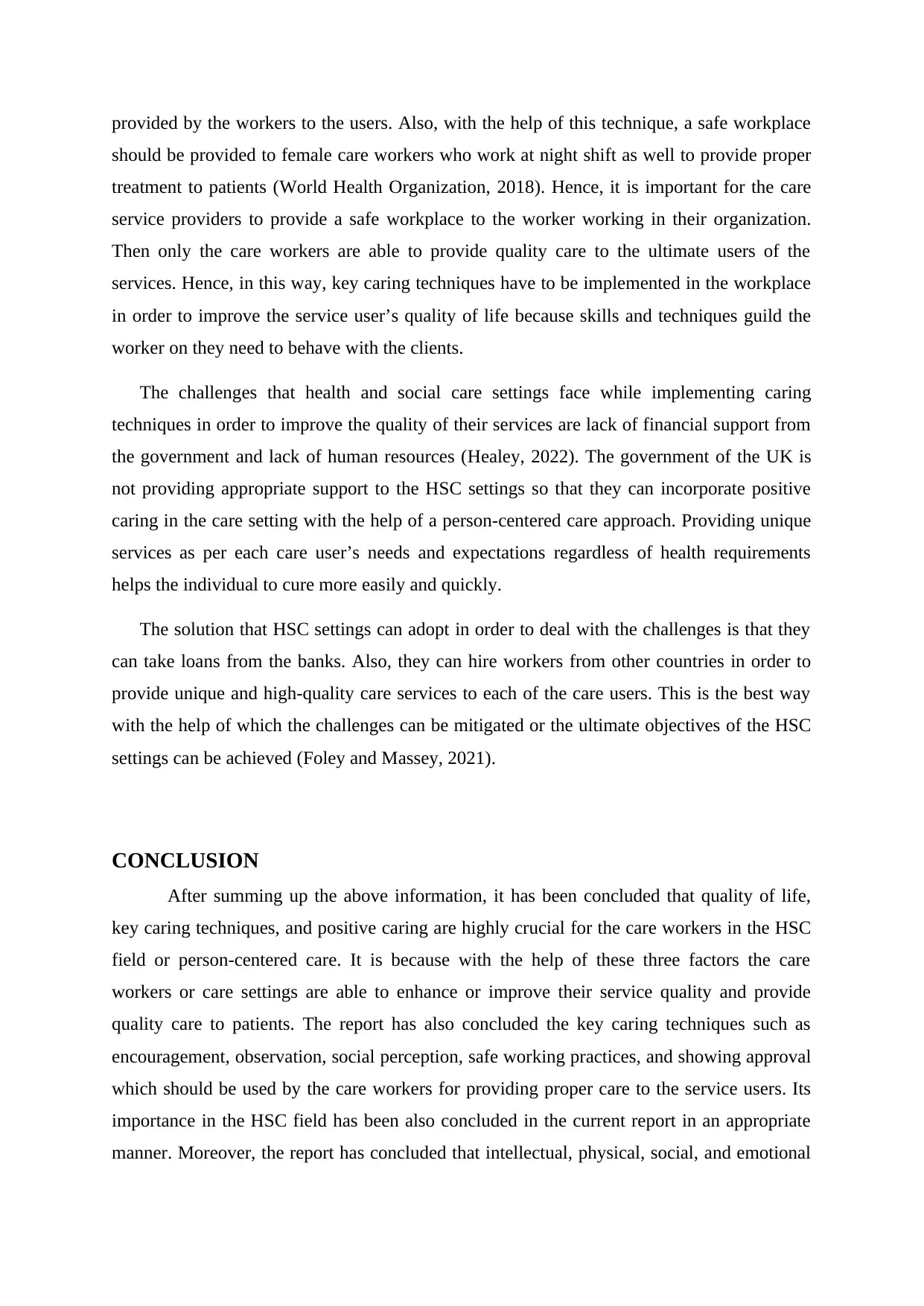
provided by the workers to the users. Also, with the help of this technique, a safe workplace
should be provided to female care workers who work at night shift as well to provide proper
treatment to patients (World Health Organization, 2018). Hence, it is important for the care
service providers to provide a safe workplace to the worker working in their organization.
Then only the care workers are able to provide quality care to the ultimate users of the
services. Hence, in this way, key caring techniques have to be implemented in the workplace
in order to improve the service user’s quality of life because skills and techniques guild the
worker on they need to behave with the clients.
The challenges that health and social care settings face while implementing caring
techniques in order to improve the quality of their services are lack of financial support from
the government and lack of human resources (Healey, 2022). The government of the UK is
not providing appropriate support to the HSC settings so that they can incorporate positive
caring in the care setting with the help of a person-centered care approach. Providing unique
services as per each care user’s needs and expectations regardless of health requirements
helps the individual to cure more easily and quickly.
The solution that HSC settings can adopt in order to deal with the challenges is that they
can take loans from the banks. Also, they can hire workers from other countries in order to
provide unique and high-quality care services to each of the care users. This is the best way
with the help of which the challenges can be mitigated or the ultimate objectives of the HSC
settings can be achieved (Foley and Massey, 2021).
CONCLUSION
After summing up the above information, it has been concluded that quality of life,
key caring techniques, and positive caring are highly crucial for the care workers in the HSC
field or person-centered care. It is because with the help of these three factors the care
workers or care settings are able to enhance or improve their service quality and provide
quality care to patients. The report has also concluded the key caring techniques such as
encouragement, observation, social perception, safe working practices, and showing approval
which should be used by the care workers for providing proper care to the service users. Its
importance in the HSC field has been also concluded in the current report in an appropriate
manner. Moreover, the report has concluded that intellectual, physical, social, and emotional
should be provided to female care workers who work at night shift as well to provide proper
treatment to patients (World Health Organization, 2018). Hence, it is important for the care
service providers to provide a safe workplace to the worker working in their organization.
Then only the care workers are able to provide quality care to the ultimate users of the
services. Hence, in this way, key caring techniques have to be implemented in the workplace
in order to improve the service user’s quality of life because skills and techniques guild the
worker on they need to behave with the clients.
The challenges that health and social care settings face while implementing caring
techniques in order to improve the quality of their services are lack of financial support from
the government and lack of human resources (Healey, 2022). The government of the UK is
not providing appropriate support to the HSC settings so that they can incorporate positive
caring in the care setting with the help of a person-centered care approach. Providing unique
services as per each care user’s needs and expectations regardless of health requirements
helps the individual to cure more easily and quickly.
The solution that HSC settings can adopt in order to deal with the challenges is that they
can take loans from the banks. Also, they can hire workers from other countries in order to
provide unique and high-quality care services to each of the care users. This is the best way
with the help of which the challenges can be mitigated or the ultimate objectives of the HSC
settings can be achieved (Foley and Massey, 2021).
CONCLUSION
After summing up the above information, it has been concluded that quality of life,
key caring techniques, and positive caring are highly crucial for the care workers in the HSC
field or person-centered care. It is because with the help of these three factors the care
workers or care settings are able to enhance or improve their service quality and provide
quality care to patients. The report has also concluded the key caring techniques such as
encouragement, observation, social perception, safe working practices, and showing approval
which should be used by the care workers for providing proper care to the service users. Its
importance in the HSC field has been also concluded in the current report in an appropriate
manner. Moreover, the report has concluded that intellectual, physical, social, and emotional
Paraphrase This Document
Need a fresh take? Get an instant paraphrase of this document with our AI Paraphraser
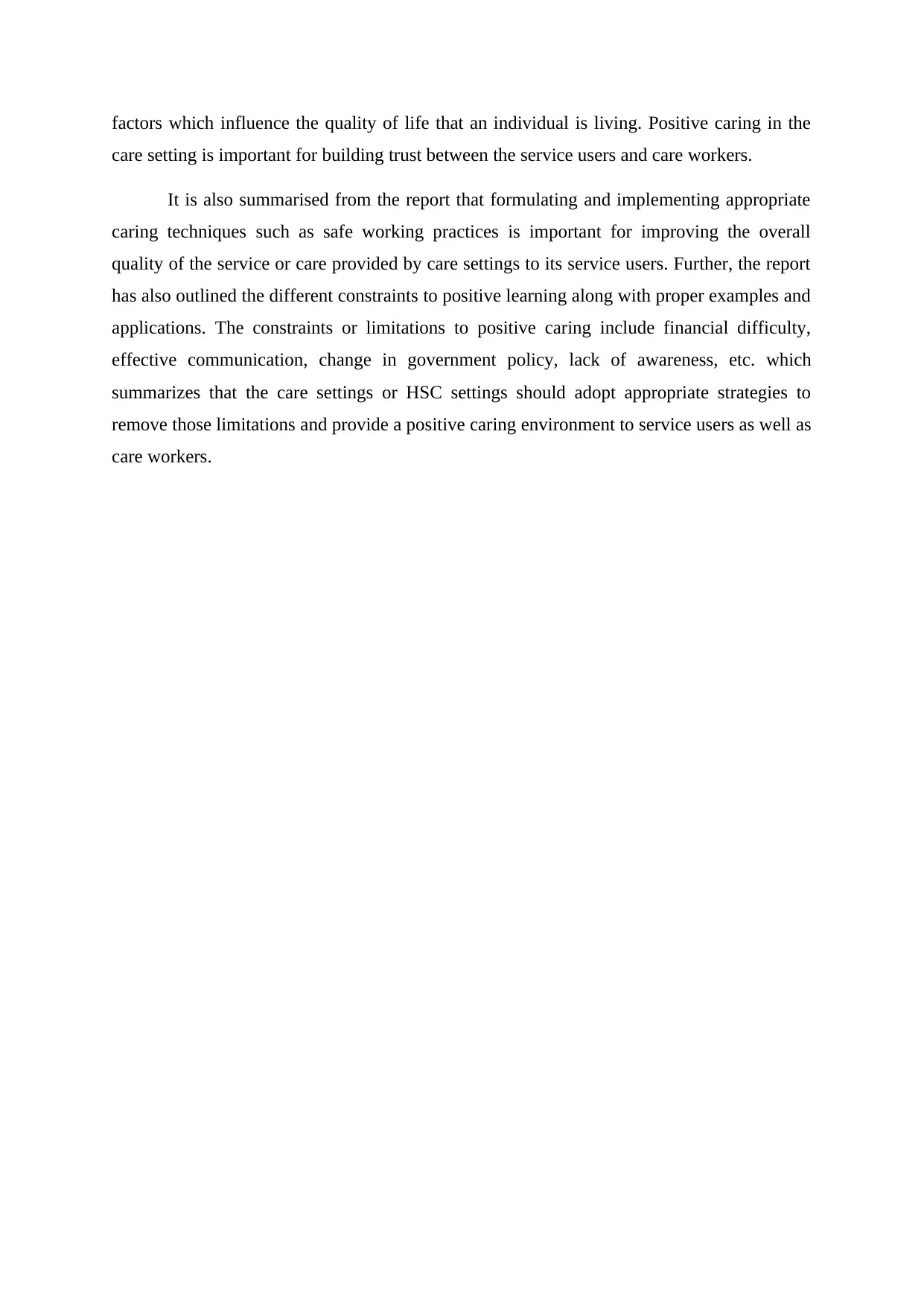
factors which influence the quality of life that an individual is living. Positive caring in the
care setting is important for building trust between the service users and care workers.
It is also summarised from the report that formulating and implementing appropriate
caring techniques such as safe working practices is important for improving the overall
quality of the service or care provided by care settings to its service users. Further, the report
has also outlined the different constraints to positive learning along with proper examples and
applications. The constraints or limitations to positive caring include financial difficulty,
effective communication, change in government policy, lack of awareness, etc. which
summarizes that the care settings or HSC settings should adopt appropriate strategies to
remove those limitations and provide a positive caring environment to service users as well as
care workers.
care setting is important for building trust between the service users and care workers.
It is also summarised from the report that formulating and implementing appropriate
caring techniques such as safe working practices is important for improving the overall
quality of the service or care provided by care settings to its service users. Further, the report
has also outlined the different constraints to positive learning along with proper examples and
applications. The constraints or limitations to positive caring include financial difficulty,
effective communication, change in government policy, lack of awareness, etc. which
summarizes that the care settings or HSC settings should adopt appropriate strategies to
remove those limitations and provide a positive caring environment to service users as well as
care workers.
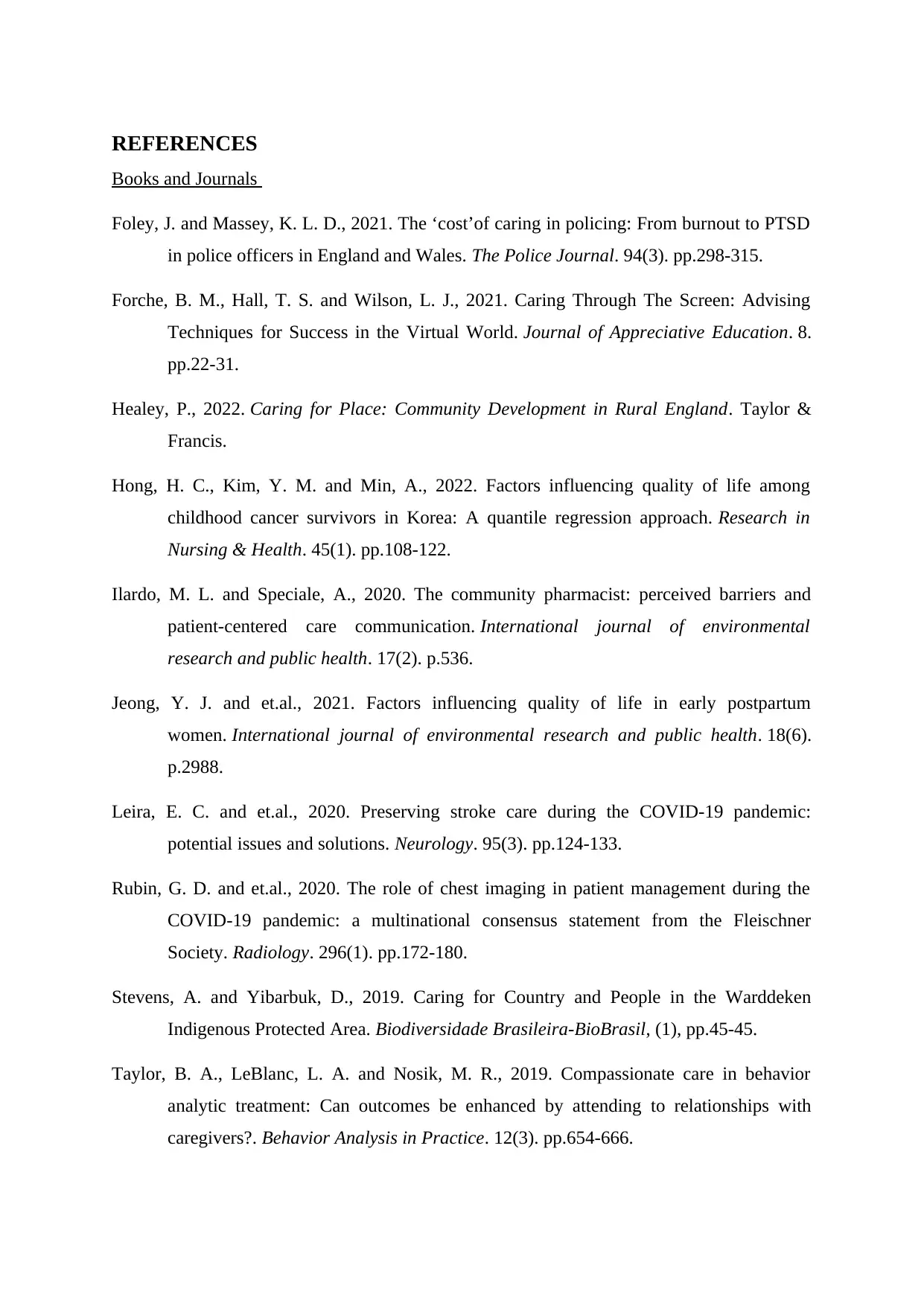
REFERENCES
Books and Journals
Foley, J. and Massey, K. L. D., 2021. The ‘cost’of caring in policing: From burnout to PTSD
in police officers in England and Wales. The Police Journal. 94(3). pp.298-315.
Forche, B. M., Hall, T. S. and Wilson, L. J., 2021. Caring Through The Screen: Advising
Techniques for Success in the Virtual World. Journal of Appreciative Education. 8.
pp.22-31.
Healey, P., 2022. Caring for Place: Community Development in Rural England. Taylor &
Francis.
Hong, H. C., Kim, Y. M. and Min, A., 2022. Factors influencing quality of life among
childhood cancer survivors in Korea: A quantile regression approach. Research in
Nursing & Health. 45(1). pp.108-122.
Ilardo, M. L. and Speciale, A., 2020. The community pharmacist: perceived barriers and
patient-centered care communication. International journal of environmental
research and public health. 17(2). p.536.
Jeong, Y. J. and et.al., 2021. Factors influencing quality of life in early postpartum
women. International journal of environmental research and public health. 18(6).
p.2988.
Leira, E. C. and et.al., 2020. Preserving stroke care during the COVID-19 pandemic:
potential issues and solutions. Neurology. 95(3). pp.124-133.
Rubin, G. D. and et.al., 2020. The role of chest imaging in patient management during the
COVID-19 pandemic: a multinational consensus statement from the Fleischner
Society. Radiology. 296(1). pp.172-180.
Stevens, A. and Yibarbuk, D., 2019. Caring for Country and People in the Warddeken
Indigenous Protected Area. Biodiversidade Brasileira-BioBrasil, (1), pp.45-45.
Taylor, B. A., LeBlanc, L. A. and Nosik, M. R., 2019. Compassionate care in behavior
analytic treatment: Can outcomes be enhanced by attending to relationships with
caregivers?. Behavior Analysis in Practice. 12(3). pp.654-666.
Books and Journals
Foley, J. and Massey, K. L. D., 2021. The ‘cost’of caring in policing: From burnout to PTSD
in police officers in England and Wales. The Police Journal. 94(3). pp.298-315.
Forche, B. M., Hall, T. S. and Wilson, L. J., 2021. Caring Through The Screen: Advising
Techniques for Success in the Virtual World. Journal of Appreciative Education. 8.
pp.22-31.
Healey, P., 2022. Caring for Place: Community Development in Rural England. Taylor &
Francis.
Hong, H. C., Kim, Y. M. and Min, A., 2022. Factors influencing quality of life among
childhood cancer survivors in Korea: A quantile regression approach. Research in
Nursing & Health. 45(1). pp.108-122.
Ilardo, M. L. and Speciale, A., 2020. The community pharmacist: perceived barriers and
patient-centered care communication. International journal of environmental
research and public health. 17(2). p.536.
Jeong, Y. J. and et.al., 2021. Factors influencing quality of life in early postpartum
women. International journal of environmental research and public health. 18(6).
p.2988.
Leira, E. C. and et.al., 2020. Preserving stroke care during the COVID-19 pandemic:
potential issues and solutions. Neurology. 95(3). pp.124-133.
Rubin, G. D. and et.al., 2020. The role of chest imaging in patient management during the
COVID-19 pandemic: a multinational consensus statement from the Fleischner
Society. Radiology. 296(1). pp.172-180.
Stevens, A. and Yibarbuk, D., 2019. Caring for Country and People in the Warddeken
Indigenous Protected Area. Biodiversidade Brasileira-BioBrasil, (1), pp.45-45.
Taylor, B. A., LeBlanc, L. A. and Nosik, M. R., 2019. Compassionate care in behavior
analytic treatment: Can outcomes be enhanced by attending to relationships with
caregivers?. Behavior Analysis in Practice. 12(3). pp.654-666.
⊘ This is a preview!⊘
Do you want full access?
Subscribe today to unlock all pages.

Trusted by 1+ million students worldwide
1 out of 13
Related Documents
Your All-in-One AI-Powered Toolkit for Academic Success.
+13062052269
info@desklib.com
Available 24*7 on WhatsApp / Email
![[object Object]](/_next/static/media/star-bottom.7253800d.svg)
Unlock your academic potential
Copyright © 2020–2025 A2Z Services. All Rights Reserved. Developed and managed by ZUCOL.





